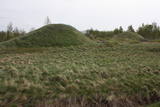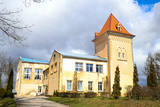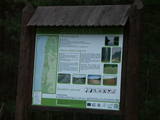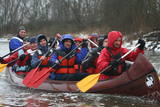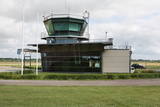| Nr | Name | Beschreibung |
|---|---|---|
|
Gebaut am Ende des 13. Jh. als eine dreischiffige Basilika im romanischen Stil mit gotischen Elementen. 1853 wurde der 65 m hohe Turm aufgebaut (Aussichtsplatz). In der Kirche befinden sich die Grabsteine der livonischen Bischöfe, Kanzel (1748), Altar aus Eichenholz (1858), Altarbild (1862), Buntglasfenster und eine der besten Orgeln Lettlands (1907). |
||
|
In der Getreidedarre des Hofes Atāli auf der Insel Putnu sala (Vogelinsel) hat die örtliche Heimatkundlerin Ārija Gruberte 20 Jahre lang Haushaltsgegenstände gesammelt, die in der Umgebung des Urstromtales von Dviete verwendet worden sind. In der Ausstellung kann man verschiedene Gegenstände aus der Steinzeit, Eisenzeit und aus dem Mittelalter besichtigen, die zufällig gefunden worden sind und die über das Leben der Menschen innerhalb von 10 000 Jahren zeugen. Den Besuch bitte vorher anmelden. |
||
|
In der Zeit der Sowjetunion wurden in der Nähe vom Flughafen Liepāja in Cimdenieki die Radiolokatoren für die Flugabwehr aufgestellt. Heutzutage sind die Radiolokatoren demontiert und im Platz, wo sie waren, sind nur zwei interessante künstlich gebildete Reliefformen erhalten geblieben.
|
||
|
Saimniecība nodarbojas ar 15 veidu vīna darīšanu no Latvijas augļiem, ogām un citām dabas veltēm, kā arī vīna destilāta ražošanu. Vīna darītavā vīndaris pastāstīs par vīna izgatavošanu un dalīsies savā pieredzē. Uz vietas iespējams nobaudīt dažādus izsmalcinātus augļu un ogu vīnus, meklējot sev tīkamākās garšu un smaržu nianses. Vīna darītava sadarbojas ar vietējo zemnieku saimniecībām, tēdēļ pie vīna iespējams nobaudīt sieru no govs vai aitas piena un Bauskas pusē ražotus saldumus. |
||
|
Atrodas Labraga – Apriķu ceļa malā. Kāds nostāsts vēsta, ka to 1896. gadā cēlis vietējais muižkungs, kurš vēlējies, lai viņa meitas laulības notiktu baznīcā. Dievnamā atrodas altārglezna "Kristus pie krusta un Sv. Marija Magdalēna", kas gleznota 19. gadsimtā (autors T. Šprengels). |
||
|
Um den Fluss Daugava aus einer anderen Sicht zu sehen, kann man vom Bäckerei-Geschäft der Firma „Liepkalnu maiznīca” eine Ausfahrt mit einem Langschiff der Wikinger „Lāčplēsis” machen, der gleichzeitig eine Gruppe von 24 Personen an Bord aufnehmen kann. Daugava war schon von alters her ein bedeutender Wanderungskorridor nicht nur für verschiedene Pflanzen- und Tierarten, die dadurch auf das jetzige Territorium Lettlands “gekommen” sind , sondern auch für Leute und Stämme, die die Daugava-Ufer und die Ostseeküste besiedelten. |
||
|
Atrodas netālu no Biksēres muižas, blakus muižas parkam. Ozolkalna klēts saimniece Līga Kuba aušanas prasmes pirms pāris gadiem apguvusi Sarkaņu amatu skolā. Šeit radusies iecere par privātas aušanas darbnīcas izveidi, kas arī īstenota. Saimniece savas aušanas prasmes nodod jebkuram interesentam. Apmeklētāji var iegādāties šeit darinātos suvenīrus. |
||
|
Eins der eindrucksvollen Wasserfälle Estlands (ung. 8 m), „wiedererlebt” nach den reichlichen Niederschlägen und im Früfling bei Hochwasser. |
||
|
Die Küstenbildungen des alten Ostseestadiums – Littorina-Meer treten in Natur als eine nicht große und flache Steilküste auf, die sich etwa vor 4500 – 5000 Jahren bildete. Ein Material der Küstenablagerungen – Geröll und Kies beinhalten ein für das Littorina-Meer kennzeichnendes reichstes Komplex der Faunareste. Am Besten ist der alte Meeres-Steilhang bei dem Hof “Dobeļi” in Kaltene zu beobachten. Der Steilhang der alten Küste in Kaltene ist einer der wenigen Abschnitte an der Küste der Rigaer Bucht, wo während des Littorina-Meeres eine Abrasionsküste war. In den flachen Meeresbuchten nähren sich und erholen sich die Zugvögel. (Die Quelle: Roja TIZ) |
||
|
Diese Tour bietet die Möglichkeit, hinter den gewöhnlichen Sehenswürdigkeiten zu schauen und die drei baltischen Staaten näher kennenzulernen. Die Tour fängt in Riga – in der historischen Hauptstadt Lettlands an, danach führt sie durch den Nationalpark Gauja mit seinen Burgen, Schlössern und Naturpfaden. Steigen Sie auf den Turm der mittelalterlichen Burg von Turaida und genießen Sie die wunderbaren Aussichten über das Urstromtal des Flusses Gauja und besuchen Sie den Meisterschmied der antiken Schmuckstücke in der Burg der reizvollen Stadt Cesis. Wenn Sie die Grenze nach Estland überquert haben, können Sie einen Spaziergang durch den Kurort Parnu unternehmen und seine eleganten Villas besichtigen, und danach die Fähre zu der Insel Saaremaa nehmen. Die typische Landschaft der Insel zeigt sich in dem ethnographischen Dorf Koguva, in den alten Kirchen und Windmühlen. Dann ist die Zeit für Tallinn mit ihrer mittelalterlichen Altstadt und für den Nationalpark Lahemaa mit seinen Fischerdörfern und Landgütern gekommen. Probieren Sie estnische Küche in der Kneipe Altja. Wenn Sie zurück fahren, besichtigen Sie die Universitätsstadt Tartu. Wenn Sie wieder in Lettland sind, besuchen Sie Ziegenzüchtereien und eine Bäckerei, die das lettische Schwarzbrot traditionell backt. Danach führt die Tour Richtung der westlichen Küste mit den Städten Liepaja und – auf der anderen Seite der Grenze, in Litauen – mit Klaipeda. Der nächste Stopp ist die wunderschöne Kurische Nehrung. Vor der Stadt Vilnius können Sie einen Abstecher zum Grutas Park mit seinen eigenartigen Skulpturen aus der Sowjetzeit machen. Beenden Sie Ihre Tour an der malerischen Burg Trakai in Litauen und an dem Schloss Rundale in Lettland. |
||
|
Die nach dem Bau der Straße Tallinn – Narva gefundene und rekonstruierte 36 alte Bestattungen (8. – 7. Jh. vor Christus) ist ein interessantes archiologisches Denkmal mit einem Besucherzentrum und einer geschichtlichen Ausstellung. |
||
|
Druvienas muižas pirmsākumi ir meklējami 17. gs. beigās. Tagad redzamā apbūve ir veidojusies 19. – 20. gs. Līdz mūsdienām ir saglabājusies muižas pils (1898. g.) un saimniecības ēkas – klētis, kūtis, kalpu mājas. Muižas pilī 20. gs. 50. gados izvietoja pamatskolu. Diemžēl sākotnējie ēkas interjeri nav saglabājušies. Pili ieskauj parks. Šobrīd ēkā atrodas Druvienas Latviskās dzīvesziņas centrs, kas piedāvā dažādas aktivitātes un radošās darbnīcas. |
||
|
Errichtet an der Stelle, an der im Ersten Weltkrieg 1916 die sogenannte Weihnachtsschlacht der russischen gegen die deutschen Truppen stattfand. Nach dieser Schlacht wurde der Mut und die Heldenhaftigkeit der lettischen Schützen weit über die Landesgrenzen hinaus bekannt . Auf dem Ložmetējkalns (Maschinengewehrberg) ist eine Gedenkstätte für die lettischen Schützen errichtet und ein Aussischtsturm erneuert worden. Von dort aus sieht man das Maztīreļa purvs (Kleinheide Moor), die Stelle, an der ehemals eine deutsche Schmalspurbahn in Nord-Süd Richtung kreuzte, ist noch gut zu erkennen. Hier kann man sich auf eine Wanderung mit oder ohne Führer begeben, das Mangalis-Haus des Weihnachtsschlachtmuseums besuchen, in dessen Nachbarschaft eine Erkundungsroute errichtet ist, oder an thematischen Bildungsveranstaltungen und Schlachtimitationen teilnehmen. Zu besichtigen sind Denkmäler, Soldatengräber, Ausgrabungen, Fortifikationen, Erdhütten und mehr. Es gibt auch einen an autentischer Stelle rekonstruierten Abschnitt eines Befestigungssystems – einen Schutzbau und einen Teil der ersten deutschen Schutzlinie, den sogenannten „deutschen Wall“. |
||
|
Eine schöne malerische Flussstrecke zwischen Alytus und Pakuoni, wo der Fluss mehrere breite Mäanderkrümmungen mit bis zu 40 m hohen Mörenenabdeckungen macht (Balbieriškio-Abdeckung u.a.). |
||
|
Atrodas Līvānu ziemeļdaļā, Baznīcas ielā 17. Dievnams uzbūvēts 1861. g. un paplašināts 1880. gadā. Pēc nopostīšanas 1. pasaules kara laikā to atjaunoja 1918. gadā. No interjera ievērības cienīgas ir ērģeles (uzstādītas 1936. g.), glezna „Svētais Jānis Kristītājs” (mākslinieks Šēnbergs) un 14 Krusta ceļa gleznas, kas ir vācu mākslinieka Fogela gleznu kopijas (19. gs. pirmā puse). Kopš 20. gadsimta sākuma bez izmaiņām ir saglabājies tikai Ostrabramas Dievmātes altāris ēkas labajā pusē. 2007. gadā nokrāsoja dievnama fasādi. Šo darbu laikā, no ēkas sienas izņēma nesprāgušu artilērijas lādiņu, kas bija iestrēdzis 1. pasaules kara laikā. |
||
|
Dieses Territorium umfasst den Küstenabschnitt zwischen der Straße Ventspils-Liepāja und der Ostsee auf beiden Seiten des Flusses Užava. Das Gebiet wurde eingerichtet, um sowohl die Küstenbiotope wie die Graudünen und als auch eine Reihe von gefährdeten Pflanzen zu schützen. Südlich der Mündung der Užava steht oben auf einer steilen Düne einer der romantischsten Leuchttürme von Lettland – der Užava – Leuchtturm.
|
||
|
The large farm is to the South of the centre of Lone, producing apples, pears, plums, cherries, strawberries and black currants. It stores apples during the whole winter. You can help to pick the fruit and berries and purchase them for yourself. |
||
|
Gegründet für den Schutz der Kurischnen Nehrung (die größte Dünenformation im Baltikum), Küstenbiotopen, des kulturhistorischen Erben und der kultorologischen Ressourcen. |
||
|
Angebote zum Natururlaub: Seekajakwanderungen im Sommer, Schneesschuhwanderungen im Moor im Herbst und im Winter, Kanuwanderungen auf Flüssen im Frühjahr |
||
|
Der heutige Flughafen von Ventspils wurde früher als ein Militärobjekt gebaut und als Kriegsflugplatz genutzt. Heutzutage sind die regelmäßigen Flüge nach und von Riga abgebrochen und der Flughafen wird nur für die Bedürfnissen des kleinen Flugwesens genutzt.
|
||



